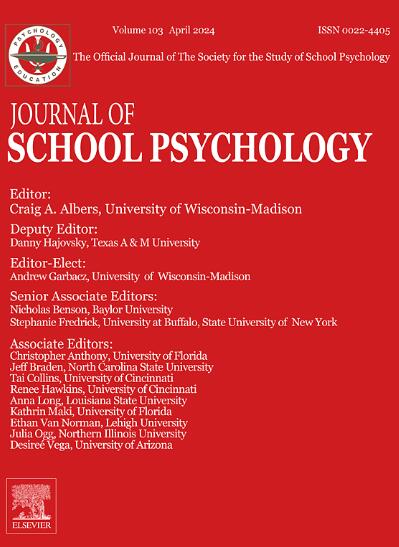Moral disengagement and defender self-efficacy as predictors of bystander behaviors in peer victimization in middle school: A one-year longitudinal study
IF 4.1
1区 心理学
Q1 PSYCHOLOGY, SOCIAL
引用次数: 0
Abstract
Numerous empirical studies have contributed to the understanding of factors connected to students' bystander behaviors in peer victimization situations. Nevertheless, a crucial gap remains concerning the scarcity of longitudinal studies. Drawing on social cognitive theory, the present study examined whether moral disengagement and defender self-efficacy predicted bystander behaviors a year later. Participants were 1346 Swedish adolescents (MageT1 = 13.6 years, MageT2 = 14.6 years) who answered a web-based self-report questionnaire in seventh and eighth grades. Random intercept models showed that higher levels of moral disengagement in seventh grade were associated with more pro-aggressive bystanding in eighth grade (Est = 0.19, p < .001), with interaction analyses revealing that this effect was particularly pronounced in students with high defender self-efficacy (Est = 0.05, p < .01). The results also revealed that higher levels of defender self-efficacy in seventh grade were associated with more defending (Est = 0.18, p < .001) and less passive bystanding (Est = −0.11, p < .001) in eighth grade. Interaction analyses further demonstrated that the negative association between defender self-efficacy and passive bystanding was significant only at low levels of moral disengagement (Est = 0.09, p < .001). Our findings suggest that moral disengagement is more strongly related to the inhibitive form of moral agency among bystanders, whereas defender self-efficacy is more strongly related to proactive moral agency. Thus, interventions aiming to reduce pro-aggressive bystanding and promote defending need to consider both moral disengagement and defender self-efficacy.
初中生在同伴伤害事件中的旁观者行为的预测因素--道德脱离和维护者自我效能:为期一年的纵向研究
大量的实证研究有助于人们了解学生在同伴受害情况下的旁观者行为的相关因素。然而,纵向研究的缺乏仍是一个重要的空白。本研究以社会认知理论为基础,考察了道德脱离和维护者自我效能感是否能预测一年后的旁观者行为。1346 名瑞典青少年(MageT1 = 13.6 岁,MageT2 = 14.6 岁)在七年级和八年级时回答了一份基于网络的自我报告问卷。随机截距模型显示,七年级时较高的道德偏离水平与八年级时较高的亲攻击性(Est = 0.19, p <.001)相关,交互作用分析表明,这种效应在具有较高防御者自我效能感的学生中尤为明显(Est = 0.05, p <.01)。结果还显示,七年级时较高的防卫者自我效能感与八年级时较多的防卫(Est = 0.18,p < .001)和较少的被动旁观(Est = -0.11,p < .001)相关。交互分析进一步表明,只有在道德脱离程度较低的情况下,防御者自我效能感与消极旁观之间的负相关才显著(Est = 0.09, p <.001)。我们的研究结果表明,道德脱离与旁观者的抑制性道德代理关系更为密切,而维护者自我效能感则与积极主动的道德代理关系更为密切。因此,旨在减少亲攻击性旁观和促进防卫的干预措施需要同时考虑道德脱离和防卫者自我效能。
本文章由计算机程序翻译,如有差异,请以英文原文为准。
求助全文
约1分钟内获得全文
求助全文
来源期刊

Journal of School Psychology
PSYCHOLOGY, EDUCATIONAL-
CiteScore
6.70
自引率
8.00%
发文量
71
期刊介绍:
The Journal of School Psychology publishes original empirical articles and critical reviews of the literature on research and practices relevant to psychological and behavioral processes in school settings. JSP presents research on intervention mechanisms and approaches; schooling effects on the development of social, cognitive, mental-health, and achievement-related outcomes; assessment; and consultation. Submissions from a variety of disciplines are encouraged. All manuscripts are read by the Editor and one or more editorial consultants with the intent of providing appropriate and constructive written reviews.
 求助内容:
求助内容: 应助结果提醒方式:
应助结果提醒方式:


